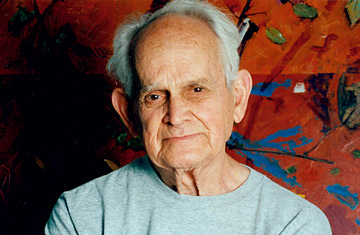
Artist Manny Farber
(2 of 4)
"Critical of Criticism"
"Doing go-for-broke art and not caring what comes of it." That's not just a critical testament, it's autobiography; Manny was that craftsman. Contributing to left-wing weeklies and film magazines — except for a few months at Time — he had all the anonymity he needed, at least relative to front-line reviewers on the newspapers and newsweeklies. Manny's pieces had no impact on a film's box office take; I don't recall ever seeing his name on a movie ad or a DVD box. Eh, so what? His reviews gave the impression that, although it'd be nice to be heeded, he didn't care if he was liked. This wasn't the case with Manny; but he certainly wouldn't play the game of critical ingratiation. Writing sentences suitable for blurbing, charming readers with equivocation ("Is it only me or...?"), bullying them with ex-cathedra opinions ("If you don't agree with me you're an idiot"): to him all this smacked of hucksterism.
"I'm very critical of criticism," he told Leah Ollman in a long Art In America interview in 2004. "The length of sentences and the amount of narcissism involved throws me all the time. People like Proust and Melville please me. They don't waste words." He denounced and avoided the critical cult of personality; "I made it a point never to use the word I in an essay, an article," he told Ollman. Though hardly a hermit, he avoided the community of critics and the proximity of the people he wrote about. "Anonymity and coolness... writing film-centered criticism rather than self-centered criticism," was one of the seven "Critical Precepts" that he and Patricia Patterson — Manny's intimate collaborator in his writing, arting and, for 40 years, life — laid down in Film Comment in 1977. "With few exceptions, we don't like meeting the movie director or going to press screenings."
Along with this remove from the action was a demotion of opinion, which for many critics is the meat of a review. David Thomson, who's up there with Manny in the film-critical pantheon, said after his death that, rereading him, he couldn't always tell what Manny thought of a film — not that analysis was lacking, just an overall value judgment. I don't think that rendering an Olympian opinion was crucial for him. It was more important to look at the work closely, tunnel into its rhythm and visual texture, then write it up, with special attention to originality of expression and sentence-solving, so that the reader can approach the finished piece with the same concentration, and expectation of rewards, as any work of art. "I believe most of what I wrote," Manny told Ollman with a disconcerting blitheness, "but I'm more interested in the elegance of the word and what it throws up at you."
Manny's art-view was clear enough. "To put Hitchcock up or down isn't the point," he wrote in the essay "Clutter" in the late '60s; "the point is sticking to the material as it is, rather than drooling over behind-the-camera feats of engineering." Anyway, it was impossible to mistake his authorial personality — or, rather, his restless mind and outsize intelligence. When I knew Manny, his receding hairline gave him a forehead as high as Jeff Morrow the Metalunan's in This Island Earth, and inside this gigantic braincase all manner of creatures crawled, gnawed and sang.
A master of sprung rhythm, he could pack a half-dozen insights into a 100-word sentence on Chuck Jones and the Warner cartoon crew — "Despite the various positions on humor (Tex Avery is a visual surrealist proving nothing is permanent, McKimson is a show-biz satirist with throw-away gags and celebrity spoofs, Friz Freleng is the least contorting, while Jones's specialty, comic character, is unusual for the chopping-up of motion and the surreal imposition: a Robin Hood duck, whose flattened beak springs out with each repeated faux pas as a reminder of the importance of his primary ineptness), the Warner cartoonists are refreshing iconoclasts because they concentrate on so many other humor antecedents besides brutal mishaps, cultural punning, ballet-like sadism" — then top it with the snappy summation that "the good ones are masterpieces and the bad ones aren't a total loss."
